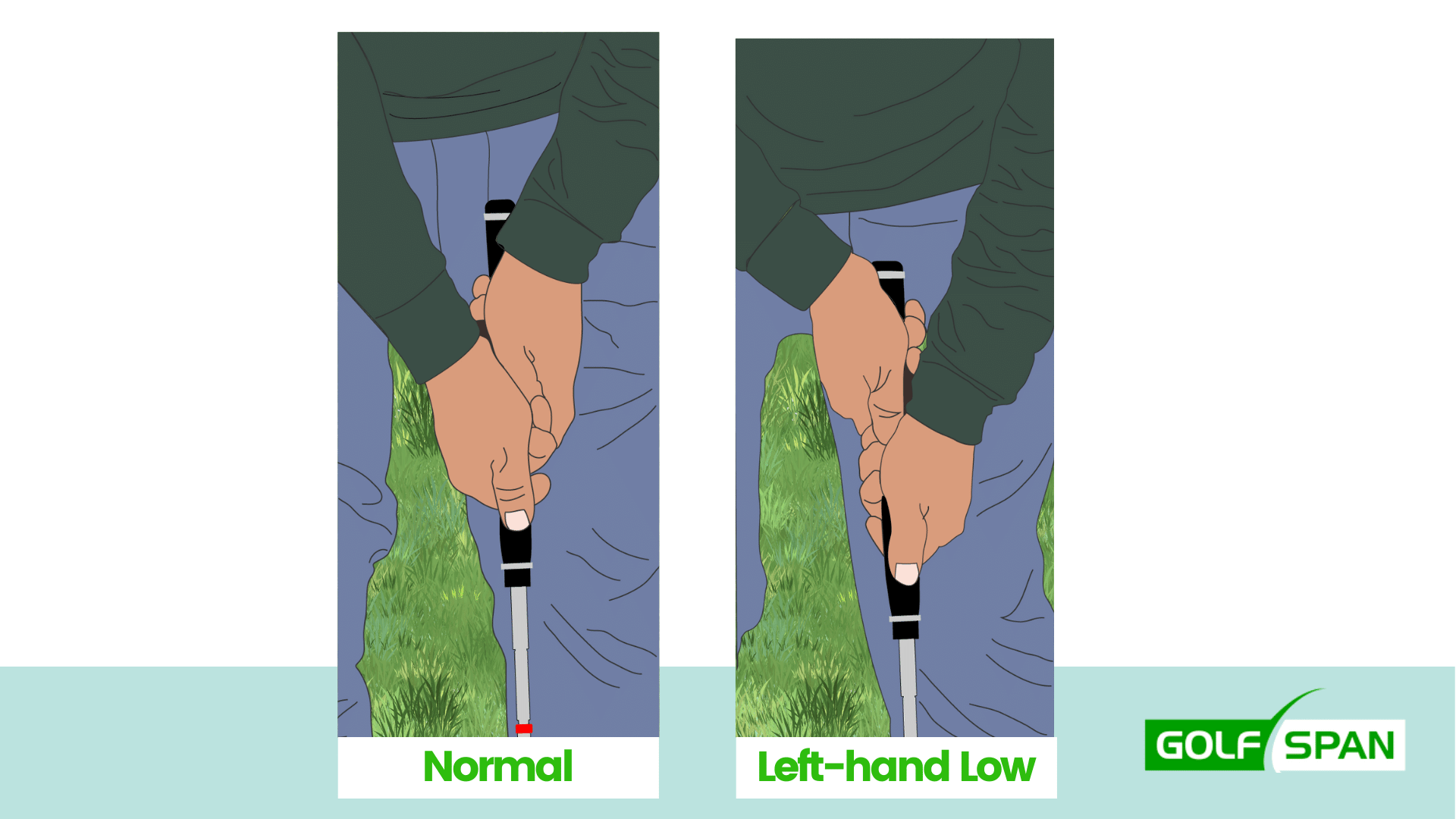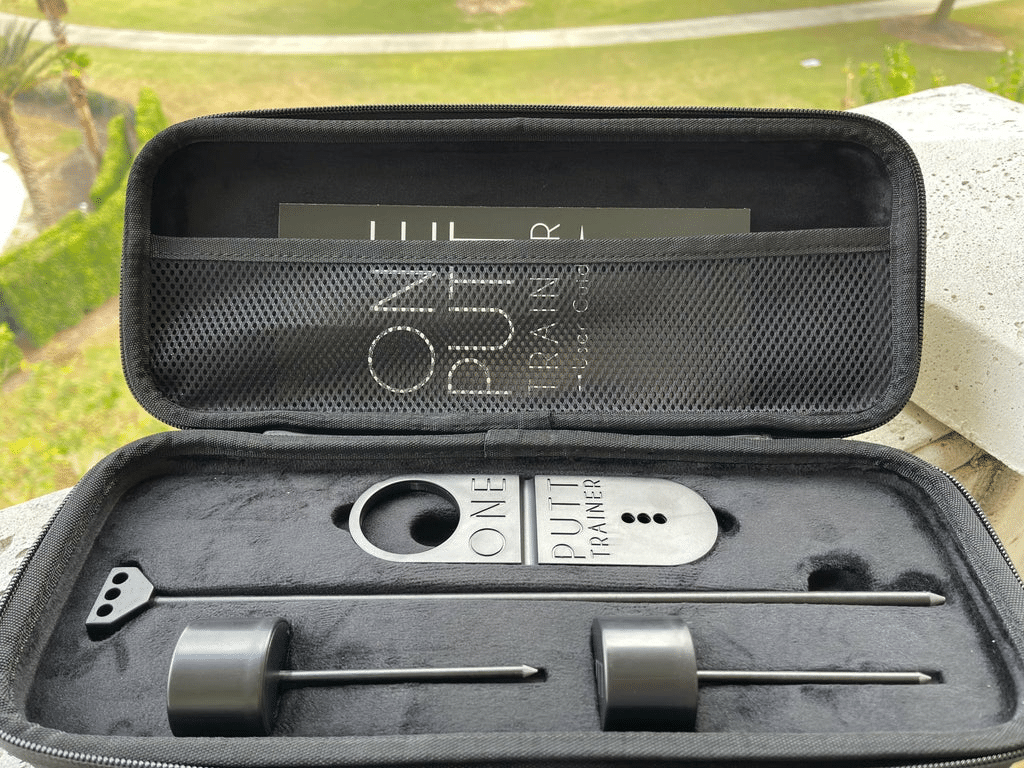If you can putt well, you can score well relative to your current handicap. The tips in this article will help transform your game by making you a better putter.
The importance of putting on a golfer’s overall game can not be understated.
On average, putting makes up roughly 43% of all the strokes you take in a round. That is more than any other singular aspect of the game.
If your putting game is weak, you could destroy your game. That’s why you’ll want to focus on improving this area.
Good putting comes from understanding the fundamentals, knowing your own tendencies, and perfecting your stroke through dedicated practice.
Today I will share with you the basic fundamentals of putting. Then you’ll learn the 10 best tips to help you conquer the greens.
13 Best Putting Tips To Take Strokes Off Your Game
The following are the 13 putting tips to help you conquer the greens.
Let’s start with putting tips for beginners, covering the fundamentals of grip and posture. Then we’ll proceed to putting tips for better players with a list of drills and training aids.
1. Choose the Right Putting Grip

Of all the various technical aspects there are in golf, there may not be one that has more variations than gripping the putter. You have various options for gripping your putter, including:
A. Normal Putting Grip
A standard putting grip is one in which the hands are structured very much like a normal grip with all your other clubs. One big difference is with the V’s that are created between the pointer finger and the thumb.
In a normal grip with an iron, or wood, those V’s would point over the trail shoulder. In putting, the thumbs will run straight down the grip’s center. This will have those V’s more in line with your chin. The back of your lead hand will face the target, and the palm of your trail hand will do the same.
In terms of connecting the hands in putting, some golfers will grip the putter exactly the same as their regular clubs, with the trail pinky finger interlocking or overlapping the pointer finger of the lead hand. Many golfers use what’s called a “reverse overlap” to connect the hands. This is where the lead pointer finger is placed across the adjacent fingers on the trail hand.
B. Lead Hand Low
This grip is basically the reversal of the hands from the standard putting grip. Your lead hand will now be set below your trail hand.
Golfers that use this popular method, such as Jordan Spieth, do so in order to achieve a consistent and reliable putting stroke by keeping your shoulders level. It also prevents your lead hand from taking over.
Have a look at my article on the Lead Hand Low Grip.
C. The Claw/Saw
This putting grip was made famous in the 1990’s. Chris Demarco really made this grip notable. With the Claw/Saw, you grip the putter as normal with the lead hand. The trail hand will then grip the club in the opposite direction. The back of the trail hand will actually face the target.
The hands are not connected in this grip style.
The purpose of this grip is very similar to that of the lead hand low. It helps take that trail hand out of the stroke.
D. Armlock
The Armlock is a fairly new style of holding the putter. The most famous player to use this grip style is Bryson DeChambeau. Other players that have played with this grip style include Keegan Bradley, Matt Kuchar, and Will Zalatoris.
Those who have adopted this style cite that the biggest benefit is that it allows for more consistency and rhythm in a stroke.
With this grip, you will use a longer putter, with a longer grip. The shaft of the putter lays against your lead forearm. The putter now becomes an extension of your lead arm.
Your lead and trail hands will hold the putter lower on the grip. Most golfers using this technique will grip the putter with a standard grip.
E. Wristlock
The Wristlock putting grip and style is a variation of the armlock. The only difference is that the shaft does not go up as far as the Armlock style. There is really no difference in the set up other than the shaft being up against the lead wrist.
Which Putting Grip Is Right For You?
With the countless variations in how you can hold the putter prevalent in today’s game, try them all! Many top tour professionals do just that.
Currently, I putt left hand low on putts inside of about 25’ and then conventional on longer putts.
If you are a golfer that struggles with pulling or pushing your putts, trying the Lead Hand Low, the Armlock, or Wristlock. This is a common flaw for many golfers. These putting styles are really all about helping in this area.
If you have never tried any of these, it could be a game changer for you! I have seen many of my students go from average putters to great ones in making a grip change.
How Much Grip Pressure Should You Use?
Our hands are the only link between the club and our body. This is why, no matter what style you choose, you need to ensure that the hands set you up to control the face of the club well.
The last thought on your grip in putting is this. You want to maintain a fairly light grip pressure. On a scale of 1 to 10, with 10 being a death grip, and 1 barely holding it, you want to be about a 4 or 5.
2. Use Shoulder-Width and Triangle Posture
When considering putting tips for seniors, using the right posture can help you keep playing at a high level.
Being comfortable over the ball is important. But moving too far away from the basics of setting up to the ball in putting can start to lead to issues. Just be aware of this and adapt accordingly.
Proper setup and posture for putting should look as follows:
Step #1- Feet Shoulder Width Apart
In general terms, as you address the ball, your feet will be shoulder-width apart. For longer putts, you will get a little wider. You can also get a little wider with your stance on windy days. This will give you a better base to stay still.
Step #2- Bend Forward From the Hips
From there, you will bend forward from the hips, with limited flex in your knees.
Step #3- Position Your Arms
Your arms will hang straight down under your shoulders. You will soften your elbows with a slight bend and have them fairly close to the sides of your lower torso. Roughly near the bottom of your ribs.
I will touch on your body alignment in the next section, but remember that straight body lines are a key component to consistency with putting.
Step #4- Form the Triangle
As you get your body, specifically your arms set correctly, you will see the start of a triangle being composed. This triangle comprises your squared shoulders and your arms hanging straight down from them. Completing this triangle will be your hands, brought together as you grip the putter.
Step #5- Eyes Over the Ball
Ever wondered where to look when putting? The final setup conditions that you will want to incorporate are having your eyes over the ball and the ball in line with your lead armpit.
3. Align Your Body Parallel To The Target Line’s Left
When considering tips for high handicappers, you can take strokes off your game with minor adjustments to your alignment.
We are following the same parameters that we would in the full swing. That is having our body parallel to the target line’s left.
We want our body lines, including our toes, knees, hips, and shoulders, to be parallel to the left of our target line. For our lefty friends, you will need to flip that around…but I’m sure you are used to that being the case.
Pro Tip: Do not get into the habit that some golfers do and mistakenly line your body lines up to the target. This setup flaw will shift your target and ball line too far to the right of its intended path.
4. Use The Straight Back or Straight-Thru Stroke
There seem to be two camps in terms of the stroke itself in putting. Those that like the straight back and straight through method. And those that like more of an arc stroke that goes inside on the backstroke, squares up at impact, and exits on an inside path.
I like a little bit of a mix of the two. I subscribe to a straight back and straight-through path on short to mid-range putts (roughly up to about 20’). As putts get longer, some arcing will take place.
One common question asked by many golfers is how do we regulate distance control in putting? Simply put, the stroke’s length dictates the distance we hit the ball in putting.
Your tempo or stroke rate, should always remain the same. No matter what the length of the putt. The best putters in the world putt at a 2:1 ratio. This means that the thru stroke is twice as fast as the backstroke.
Your body must remain very still to help regulate a smooth and controlled stroke. The only thing moving, as you putt is that triangle you created in the setup. That is the arms hanging down from the shoulders and the hands gripping the putter.
More from Golfspan: How To Putt In Golf And Become A Master On The Greens
5. Close Your Eyes To Be A More Confident Putter
Golf is very much a mental game. I have heard countless times from professionals that putting is all about confidence.
“I never missed a putt in my mind” – Jack Nicklaus
But confidence won’t just come to you, so here’s a drill you can use to improve your confidence that even beginners will find value in.
Close Your Eyes Confidence Drill
A drill I put students through to help them learn how to be more confident with their putting is the close your eyes drill. Here is how it goes:
- Step #1 Start with a 3’ putt. With three balls, go through your normal putting routine, including lining up, taking your typical number of practice strokes, etc., and putt each ball. Your goal is to make all three putts.
- Step #2 Repeat step one until you hole three consecutive putts.
- Step #3 Once you have made three consecutive putts, you will once again get set at the same 3’ putt. Repeat your normal routine. This time, however, you will make three practice strokes with your eyes closed. Really feel the length of the stroke with your eyes closed.
- Step #4 Before you get ready to hit each putt, close your eyes and keep them closed as you putt.
- Step #5 Repeat step four until you hole three consecutive putts with your eyes closed.
- Step #6 After you have made three consecutive putts from 3’ with your eyes closed, you will repeat steps 1-5 but from 6’. At this point, the goal is to make two out of three putts.
- Step #7 After you have completed steps 1-5 from 6’, you will move on to a 9’ putt and repeat the process.
This drill helps build great feel and great confidence in your stroke.
To be a confident putter on the course, picture yourself making putts when you are in your pre-shot routine and making your practice strokes.
6. Create a Circle of Confidence Around The Hole
One of the most important parts of putting is limiting the number of three putts you have. Three-putting is a score-killer.
You can find some fascinating stats on three putting in this study by Shot Scope. They break down three putting woes by handicap, which is interesting.
I have taught golfers to beat the three-putt monster by defining their own personal “circle of confidence.” This is the radius around the hole at a distance that you are confident you can make the second putt.
For me, I feel pretty good about 3’ putts. So, whenever I have a putt of some distance, that three-foot “circle of trust” is my go-to.
What if I want to really give a putt for birdie a go, in that 15 to 20-foot range? I will hyper-focus on cutting that circle in half and manage my 3’ miss at or beyond the hole. For any longer putts, I stay in that “circle of confidence.”
7. Putting to an Intermediate Target is Essential
There are two factors that go into great putting. You need to have the line as well as the speed.
In terms of the line, I have always subscribed to what is known as spot-putting. This is the idea of putting at an intermediate target on your line of putt.
As I go through my putting routine, I start by looking at the line from behind the ball. Once I find the line I want, I pick an intermediate spot on that line, typically where the apex of the putt is. That becomes my focus.
After I have that, I’ll walk a circle around the hole from behind the ball. I’ll move counterclockwise as I go. I’ll stop at three, twelve, and nine o’clock points and recheck my original spot. If any adjustments need to be made, I do that with one last look down the line.
My spot becomes my focus as far as the line is concerned. I then make 2-3 practice strokes to get a feel for the stroke length I need based on the length of the putt. From there, I repeat three times, “I will make this putt,” and then I go.
Learn more: How To Read Greens
8. Putt at a 2:1 Tempo Ratio
Tempo is king in putting. As I said earlier, all great putters maintain a 2:1 ratio on all putts. Meaning, their thru-swing is twice as fast as their backswing.
To get dialed in, you can use a metronome app on your phone or even a pretty cool app called Golf BPM. This will help you develop some great rhythm and tempo.
9. Use Technology to Get Dialed In
I am a massive fan of using technology in my coaching. I use it for myself too, as I work on my own game. One amazing piece of technology that I have used off and on for many years is the Blast Golf Sensor.
This sensor, which goes on the top of the grip on your putter or other clubs, measures a great deal of useful data. In the accompanying app, you will see where things such as your backswing and thru swing time fall and your overall tempo ratio.
Using Blast will help you a great deal in getting your putting dialed in!
10. Practice Putting Everywhere
Unlike other parts of the game, putting is something that you can pretty much practice anywhere. And you really don’t even need a ball. With this being the case, there really is no excuse for not getting dialed in with your putting.
Make it a point to start incorporating some practice time daily. At work, home, at a hotel, or wherever. Taking only 10 minutes can help lead to results if repeated throughout the week.
It can be as simple as putting a ball to a coffee mug on the floor. Or, you can use change in your pocket to practice. Use two quarters to act as a gate to putt through to practice your start line.
Mix up the putting surface you putt on at home, in the office, or even at the hotel, you are staying at. Carpet, laminate, hardwood, tile. All will offer different speeds; some may even be ridiculously fast. That is good, though. It gives you some variety. What is most important is practicing your setup and stroke regularly.
A great way to do this is by using the Roll a Putt Practice Mat by Perfect Practice Putting mats.
11. Get Fit for Better Putts
As a golfer gets more and more into the game, I highly recommend that, at some point, they get professionally fit for their clubs. Getting fit for clubs can be a game changer.
I do not believe the arrow alone will improve your game. You must work on your game, preferably by getting professional coaching. But, at some point, the equipment you play, in combination with coaching and practice, can lead to massive gains.
Every student I have sent to get a professional putter fitting has dramatically improved their putting. 100% of them. This is because most golfers buy their putter right of the shelf, or off a website online. That is bad because not all golfers are built alike. Not all putting styles are built alike, either.
I would suggest starting with a putter fitting. A great place to get this done is Club Champion.
12. Buy The Right Putter Training Aid
I love incorporating training aids in my coaching. Many great training aids on the market help golfers gain the proper feel. That is what improvement is all about. It is about gaining the correct feels, especially in areas where that is lacking.
The following are some of the best training aids that I have found to help with your putting.
The Eyeline Golf Circuit Trainer
This is a newly made training aid and an awesome way to do several drills, with one training aid. I really love this new offering from EyeLine Golf. The package comes with three different trainers. Each of the three trainers offers 4 drills each. One cool thing is that the back of each trainer has a QR code that you can scan and get a direct link to the drill videos.
The Eyeline Golf Groove Putting Mirror
All of the putting mirrors that Eyeline golf offers are great. This particular model has multiple slots to put tees in to help train a variety of path issues. This is a great training aid to get your stroke dialed in.
This training aid helps with target alignment, body alignment, eye alignment over the ball, putter alignment, and path control. Many of my students instantly improve within minutes of using this. They get a whole new feel for being set up correctly.
The Eyeline Golf Stroke Meter
I have used this training aid from Eyeline Golf for many years. This really helps golfers get a feel for a stroke that is equal in the back and through swing length on various distance putts.
Award-winning PGA Professional Todd Sones, the developer of the Eyeline Stroke Meter is a friend of mine. He walked me through this training aid firsthand.
The goal of the Stroke Meter is to help you develop a stroke that is the same length back and through, at a consistent rate of acceleration. The color blocks on the board let you see equal distances back and through.
This device is great for kids and beginners. It is also a great reminder tool for more seasoned golfers as well.
The One Putt Trainer

A new training aid to the market is the One Putt Trainer. This awesome putting training aid is from the guys at Athletic Motion Golf, Mike Granato and Shaun Webb.
This, like the previous putting training aids mentioned, is great for using in multiple ways. The One Putt Trainer will train you to always start the ball on line. You’ll also learn how to improve your green reading, speed, alignment, and consistency.
This is definitely worth the look!
Check out more here: The 10 Best Putting Aids
13. Use The Best Putting Drills
Some amazing putting drills that you can incorporate into your game come directly from the guys at Athletic Motion and are in the video at the bottom of this section. I mentioned Mike Granato and Shaun Webb, with the One Putt Trainer above in my training aids section.
I wanted to highlight a great drill with the One Putt Trainer: the Start on Line Drill. This helps in getting your ball started on line. What you do is as follows…
Start On Line Drill
- Find a level and fairly straight 4’ putt on the green
- Using the two pucks that come with the kit, you will set up a gate where you are most comfortable. There are 3 settings. A beginner setting, medium setting and pro setting.
- You will be putting the ball from two putter head lengths away from the gates. Your goal is to try and get the ball through the gates on its way to the hole.
- Repeat this as many times as you would like.
- Back up to further distances and putts with some break too, to help further your practice.
Helping Mike and Shaun in these drills below is fellow North Florida PGA member Matt Borchert. Matt is a PGA Professional from Isleworth Golf and Country Club in Orlando. Matt is one of the best players in our PGA section here in Central Florida.
Check out more from Golfspan: The 12 Best Putting Drills To Sink More One Putts
In Summary
With roughly 43% of all the strokes you make during a round are with the putter. You really need to try to get dialed in with the flat stick. My hope today was to give you a primer on putting fundamentals and some of my best tips.
Of all the parts of the game where amateurs could potentially reach professional levels, putting would be it.
With dedicated practice on the greens, you could shave as many as 5, 6, 7, or more shots from your current average. That could add up to some more money in your pocket when playing your regular weekly game!
Brendon is Class A PGA Professional and founded Little Linksters, LLC, and its nonprofit arm, the Little Linksters Association for Junior Golf Development. He won 25+ prestigious industry honors, including the 2017 PGA National Youth Player Development Award. He graduated from the PGA of America Management Program and has a handicap index of 7.8.
He has played golf for over 40 years and currently plays twice a month at the Eagle Dunes Golf Club near Sorrento, Florida. He loves Srixon clubs and plays a ZX5 driver with Z 585 irons. He's written over 60 articles on GolfSpan and specializes in sharing tips to improve your golf game. You can connect with Brendon at LinkedIn, X, IG, FB, his website, or BrendonElliott@pga.com.







